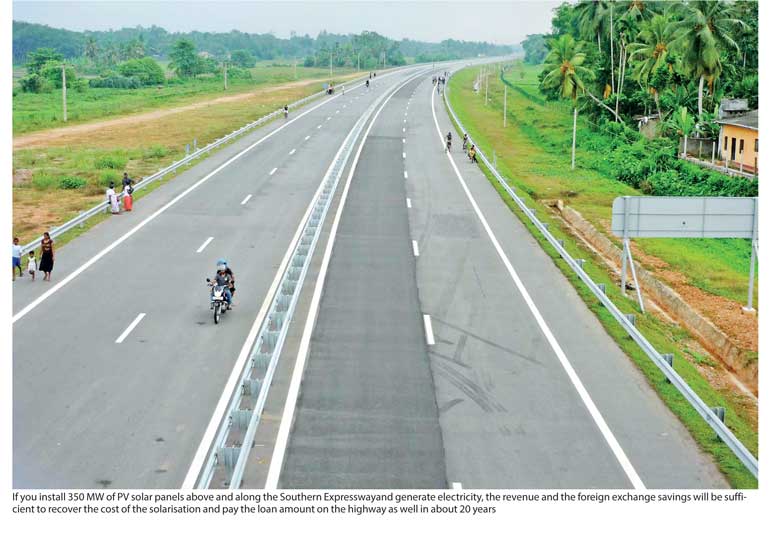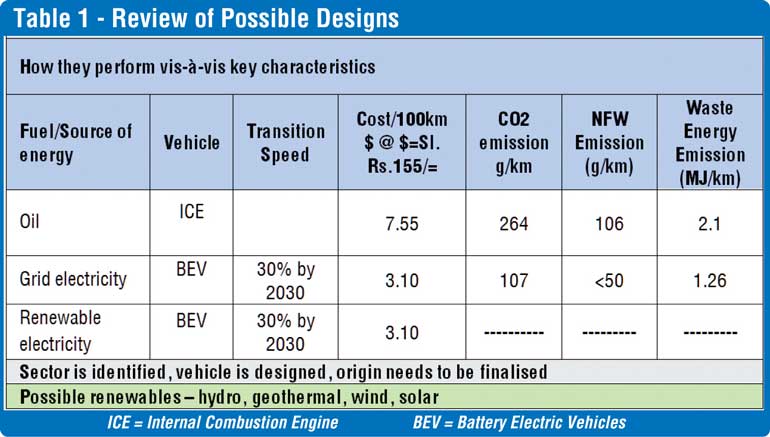Saturday Apr 19, 2025
Saturday Apr 19, 2025
Friday, 23 March 2018 00:00 - - {{hitsCtrl.values.hits}}


 Fortunately for me,W.A. Wijewardena wrote an article on Dhammika Perera’s presentation at the Colombo School of Business and Management on ‘My entrepreneurship mind and leadership heart’. If not for that article, I would not have known aboutcomments on green cars made in the presentation and might not have brought these aspects to Daily FT readership.
Fortunately for me,W.A. Wijewardena wrote an article on Dhammika Perera’s presentation at the Colombo School of Business and Management on ‘My entrepreneurship mind and leadership heart’. If not for that article, I would not have known aboutcomments on green cars made in the presentation and might not have brought these aspects to Daily FT readership.
According to the article, Perera has said that one needs to (a)have an inquisitive mind (b)adopt a scientific approach, (c)challenge existing knowledge–getto know the existing knowledge first (d)probe, criticise and (e) conclude on evidence. According to him,one also needs to remember that (i)you might get challenged by someone with better evidence, (ii)bad economists see only what is seen and (iii) good economists see what is to be foreseen as well. We also hope Perera with an entrepreneurship mind and leadership heart will verify the statements I make here and make full use of the same.
We have written extensively on green cars during the last 60 months and almost monthly during last eight months. In both writing those articles as well as writing this article,I am showcasing nothing, but the outcome of my endeavours at adopting the above-mentioned advice, a to e.
Economists world over have known about the greenness of green cars and how to measure the same. Prof. Joseph Stiglitz,Nobel Prize winner who was here and recommended a Green Economy for us, Christine Lagardeat IMF and those economists at Bloomberg, etc., who contributed to the document ‘green economy’ published by the UNEPin July, 2011 allknew about these.
When we started our research on climate change, we had to decide on sector we would concentrate on. We identified transportation sector as sector in immediate need arising fromtwo considerations: it is the most wasteful sector which implied that you could get maximum benefit from least effort and it was the most challenging sector.
We already had in 2008, three important references on them i.e. existing knowledge: (1) MIT's Ph.D. thesis ‘On the road in 2035,’ (2) IPCC's TAR 4 2007 and (3) ‘Transport Technologies and Policy Scenarios to 2050’ of World Energy Council 2007. It was after studying these that we predicted i.e. foreseen, that ultimate winner will be the BEV in an article in an English daily in February of 2011. It was in July 2011, Prof. Henry Lee of Harvard Kennedy School published his own conclusion from a detailed mathematical modelling exercise that the ultimate winner will be BEV. We wanted to run to where the ball is going to be and not to where the ball is.
From ‘On the road in 2035,’ we learnt that (i) a normal Toyota Camry would consume 2.85 MJ/km of energy and (ii) the electric Toyota Camry would consume only 0.54 MJ/km. While the first one was from tank—to—wheel, the second one was from battery—to—wheel. So, the normal ICE powered vehicle using gasoline wastes 80% of energy in the fuel; in fact, Brian Dumaine titled the Chapter 5 of his book ‘Plot to Save the Planet’ as ‘The vehicle you are driving was designed by a mad man’.
We measure overall greenness of a vehicle using the greenness associated with the two stages; welltotank and tanktowheel. We generally use CO2 emitted, waste heat emitted and Newly Formed Water (NFW) vapour formed. This last one is a parameter used only by us. It throws out the impact of a fossil fuel fired vehicle not only in respect of increased temperature, but also in respect of increased precipitation and wind.
When we identified the BEVto be a good competitor to be the winner as the greener vehicle, we carried out a fresh analysis on the emission of greenhouse gases and waste heat and the table (Table 1)indicates the outcome of that analysis. Please note that the emissions for the BEV are from the storage tank of power plant to the wheel (it includes emissions at the power plant).
Then they, foreign scientists–e.g. Prof. Marc Dallucci of California at Davis and Prof. Marc Jacobbson of Stanford who published a two--part article on their ‘Wind, Water and Solar Infrastructure’ in Energy Policy in August, 2011– startedlooking at ways and means of making green cars greener and that approach led them to use of renewable energy.
Hydro was already available and they started looking at others like solar, wind, etc. Each one of them had some disadvantages. Take for example a hydro power plant. It does not generate CO2, but it needs deforestation to accommodate water reservoirs. Then that amount of CO2 which was getting absorbed by vegetation earlier for photosynthesis would not get absorbed,but would accumulate.In effect it will be similar to the generation of New CO2 before deforestation.
Then the solar radiation which was getting converted to chemical energy during photosynthesis will not be thus converted. Solar radiation which was being reflected to extent of 15- 25 % will not get reflected as water reservoirs at 7 degrees latitude will reflect only about 6-10% of incident solar radiation. Even if you look at a solar park, you will see a similar set up in respect of the deforestation required and the CO2 left behind.
When we encounter a situation like this where we have a solution providing us a partial benefit, what we need to do is not to discard the whole thing; but to see how we could get abenefitfrom the other element as well. Our consistent effort to find a greener approach to road transportation led us to identify a much greener approach to road transportation. This is by laying Photovoltaic Solar Panels above and along the highway and using that energy to supply to the grid or battery electric vehicles.We have analysed this from a large number of perspectives and results from these have been published almost every month in the local papers.
Two other important aspects of this solution are:
i) it prevents absorption of at least 1.4 kWhrs of solar radiation by the roadway leading to global warming for every 1 kWh of energy supplied to grid or battery electric vehicles. This is due to very low albedo (0.08—0.20) of the highway.Please note that a 10 km stretch of Humes Freewayin Australia melted and was closed for traffic in the first weeks of this year.
ii) When this energy from highway solarisation is used to charge BEVs on the same highway, transmission losses that would result from using energy developedelsewhere could be eliminated.
From an economist’s point of view, this arrangement would have the unique advantage of developing a tradable product on loan funded infrastructure.If you look at theextension ofSouthern Expressway—96 km from Matara to Hambantota—to be built with $ 1.7 billion loan at 2% interest, situation will be as follows. The interest will be Rs. 5 billion a year and toll fee to be received will be approximately that much. In fact, toll fee on the Southern Expressway last year was only Rs. 5 billion. So, you will see that we would be able to pay only interest and loan amount will remain unchanged at Rs. 255 billion or increase with depreciation of the rupee.
But if you install 350 MW of PV solar panels above and along the highway and generate electricity, the revenue and the foreign exchange savings will be sufficient to recover the cost of the solarisation and pay the loan amount on the highway as well in about 20 years.Is it a worthwhile investment from the perspective of a good economist?
The potential of highway solarisation project will be determined by (a) the demand for electricity for current users, (b) level of electrification of vehicles and (c) variations in the price of oil. Demand for the current uses of electricity will increase significantly due to the Port City project, tourism and Megapolis project. One key aspect here is that according to the long-term generation plan of CEB, the peak demand in 2030 will be 4,726 MW during the day time, which indicates a significant demand.
Level of electrification of vehicles will depend on the potential for supply of BEVs by the manufacturers (say French will manufacture only BEVs by 2040), examples set by India and others (100% BEVs by 2035) and our own promotional activities through special tariffs and duty waivers. Our estimate for oil price is that very soon, OPEC and other oil producers will decide to maximise what they could get from what they have while there is a demand – say before BEVs reach 50% of global usage – and increase the price of oil and a decent estimate is $ 100 per barrel by end of the year; Goldman Sach’s estimate is $ 80 per barrel by September, 2018.
Sri Lanka should have the potential to establish about 3,800 MW of PV solar panels above and along the Highways so that it will generate a revenue of about $845 million per year. Here we have spoken about the revenue in Sri Lanka only, but the project has tremendous scope in other countries in South Asia, Philippines and in African countries.
Our own President just returned from the International Solar Alliance aiming to promote use of solar energy in countries within the Tropics of Cancer and Capricorn and we dealt with the issues for these countries in our most recent article on moving the Doomsday Clock a few seconds back. So, any local entrepreneur with decent connections in these territories should be able to promote the project in these countries and reap the benefits.
If you look at the Fortune 500 companies, you will see that 11 companies in top 25 are companiesfrom the energy and automobile industries. State Grid, China National Petroleum, Sinopec, Exxon Mobil, Shell, BPare all there and then Volkswagen, Toyota, General Motors, Daimler Benz, Ford are also there. Any economist who has been following the trends in these industries would know that these two will undergo a revolutionary change during the next decade or so.
Please also note that it was different banks which were there at the top before the energy and automobile companies came there, at least in USA. In 1812, nine of the top 10 and 19 of the top 20 companies in USA were banks. So those who are happy about the financial companies beingat the top of the local list of best companies should remember that they can't be there permanently and the most likely companies who will replace them will be from the energy and automobile industries. Why the banks and financial institutions are there at the top of the local list of best companies may be because cash-to-cash cycle time (I first read about it in Balanced Scorecard by Robert Kaplan and David Norton) is negative for them. What that means is you pay the suppliers i.e.interest to the depositors, after you receive the interest from the customers. When the interest is high, your revenue is high and you are at the top and when the interest rates come down like in USA, Japan, etc., obviously you will move out from those slots.
So,when these two sectors – energy and automobile – getready to undergo these changes, what we need to do is to accelerate the change and carve out a portion of the new economy for us. Don't even bother about whether climate change is real or not;just concentrate on finding out how we could benefit from the change. If you can carve out a portion of the new economy for us in same ratio of the populations – our 21 million out of seven billion – wewill have a portion of about $ 11 billion per year.
Please remember that The Netherlands,the home country of Shell,is approximately the same size as Sri Lanka and even they are going to have BEVs only by 2040.With some first mover advantage and a lot of potential for highway solarisation in this region, both due to the angle of latitude as well as intensity of solar irradiance,$15 billion would not be a difficult target to achieve.
There are two other aspects to this. One is that anybody who is at the top of Sri Lanka's business set up would like to have his entity enter the Global Fortune 500 list. For that you need at least a $ 5.2 billion annual turnover and that will be a gap of about $ 4.0 billion turnover from Sri Lanka's No. 1 company.
There are two ways of bridging this gap: One is keep on acquiring more and more local companies and the other is starting a new enterprise with adequate potential. Do we have enough such companies to be acquired locally and are they adequately durable to achieve the set targets? Even if there are, at least according to one corporate strategist, entities generally start acquiring other companies when you are past your youth (‘Pursuit of Prime’ by Dr. Ichac Adizes). So,the better way to get into the Fortune 500 listing will be to start a new enterprise with adequate potential. Plant a tree with adequate potential for speedy growth potential and huge revenue potential.
Highway solarisation is the ideal business concept for this and follow it up with investment into assembly of BEVs for both the local market as well as for export to Africa, etc. This is the second issue I wanted to talk about. This will be the fastest way to get into the Fortune 500 listing for a Sri Lankan entity as well as for Sri Lanka to get over the middle income country trap. It's only after you engage yourself in the BEV manufacture you can truly benefit from the revolutionary change that is going to take place in the transportation industry. Then only you will be able to reap that $15 billion revenue target.
According to ‘Green Economy,’ global companies will invest $ 1.7 trillion per year in this green economy out of which $ 600 billion will be in energy sector and $ 350 billion will be in automobile sector. It is for this reason that (a) Prof. Stiglitz recommended in mid-2015 for us to invest in a green economyand (b) we ourselves promoted the same in our article on ‘Positive balance of trade – dream to reality’ in Daily FT in August2014.
This is another topic which has bothered me since I received the email from my batch-mate Tissa Wellappili on 3 Februarywith a link to a book by Dr. John Davy available at Google. I read in that book that the population of Sri Lanka around 1815 was about 800,000 people with 476,000 living in the maritime areas. When you look at the two areas maritime and other areas, one cannot imagine the population in the other areas being only 65% of that in the maritime areas.
According to the book, there had been 4,000 Buddhist priests who had obtained higher ordination, 4,000 people engaged in the different tasks in the palace itself. If we take it that 324,000 was the population in the other areas, and about 50% was females 20% would have been below the age of 20 years there would have been one in every 16 males above 20 years engaged in the royal palace or religious work. I think it is not possible. If you look at these figures from a rice consumption point of view, at an average rate of 0.25 kg of rice per day per person, the country would have needed only about 73,000 MT of rice per year. If each hectare yields 3,000 kg per hectare per year of two seasons it would have needed the cultivation of only 25,000 hectares which is a very small area. For this quantity of rice we would have needed only about 100,000 acre feet of water and the four largest tanks out of a total of 50 tanks in ancient Sri Lanka had 440,000 acre feet of water. Then there would have been many paddy fields which were cultivated without water from tanks. Taking into consideration that one important reason for King Sri Wickrema Rajasinghe to become unpopular with the clergy and the chieftains was building of the Kandy Lake without any benefit to the country’s economy, the existence of 50 tanks of reasonable size implies that there had been a demand for about 500,000 tons of rice per year.
As such, based on these circumstantial evidence, I believe that there would have been a much larger population in Sri Lanka during the days of the ancient kings. Of course, there would be room for somebody with better access to more accuratedata on this to come out with better estimate. You may have a lot of room and time for that; but at least in my mind, time is running out very fast for us to prevent a catastrophe to mankind arising out of this unimaginable usage of fossil fuels bringing about changes to temperature, precipitation and wind.
(The writer is Managing Director of Somaratna Consultants Ltd.)